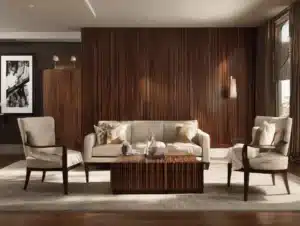Quality Veneers for Designers: Selection, Installation, and Benefits
Discover Premium Quality Wood Veneers with TruMatch
Elevate your design projects to new heights with TruMatch’s exquisite selection of wood veneers. Designed specifically for architects, designers, woodworking professionals, and manufacturers, TruMatch offers an unparalleled range of veneer sheets that combine beauty, versatility, and superior installation options.
Unmatched Selection for Every Vision
At TruMatch, the variety is as wide as the grains in our veneers. With an extensive catalog featuring a wide array of species, colors, and finishes, professionals will find the perfect match for their creative vision. Whether you are looking for a classic look with oak and walnut or a modern vibe with exotic species, TruMatch provides quality wood veneers that cater to every style and project requirement.
We have over 50 beautiful wood species in stock, with additional varieties available upon special order. These genuine wood veneers are designed to bring the beauty of real wood to nearly anything you need to cover. Some of our products are so flexible that they can literally be wrapped around a pencil! Quality, selection, ease of installation, and handling provide an outstanding product for the designer, architect, or manufacturer.
Benefits that Speak for Themselves
Wood veneers are not just about aesthetics; they bring an array of functional advantages. Lightweight yet incredibly durable, our veneers easily enhance the strength and stability of your projects without the bulk. They’re perfect for cabinets, furniture, wall paneling, and architectural elements, allowing designers to craft stunning features that stand the test of time.
Here is a quick preview of our veneer products:

Features
- Veneers of various thicknesses
- Various types of backings available, including pre-applied adhesive
- Matched or random filches
- Over 50 species of wood in stock!
– Ash,Birch, Cherry, Mahogany, Maple, Oak
Rosewood, Teak, Walnut, and many more - Can be wrapped, folded, bent, and even die-cut
- Can be laminated to many substrates, including plastic, plywood, fiberglass, steel, and aluminum. See applications for details
Backing Available
Paperback
PAPERBACK allows for great flexibility and a wide range of applications.
Thickness- 0.010”
Available sizes 4’x8’, 4’x10’ some 4’x12’
Special ordering sixes 5’x8’, 5’x10’, 5’x12’
Polyback
POLYBACK, offers the same benefits as phenolic back at half the price. This is much less rigid than the phenolic but just as durable.
Thickness- 0.020”
Available in the same sizes as the paperback
TWOPLY
TWOPLY is an excellent alternative to solid wood
Thickness – 0.020”
Available in the same sizes as the paperback
PSA
PSA backing – peel & stick backing avoids the step of applying liquid glue. Great product for DIY
Thickness – 0.005”
Available in 2’x8’ and 4’x8’

Veneer Sheets
Real wood veneer sheets permanently bonded together. Various backers are available including Paper Backed, Poly Backed, 2-Ply and PSA Backed.
Easy Installation for Timely Project Completion
TruMatch veneers come pre-sanded and ready to adhere, making installation fast and straightforward. Our commitment to quality means that every veneer sheet is expertly crafted for a seamless finish, minimizing the hassle and maximizing your productivity. With our easy-to-handle sheets, designers can focus on creativity rather than complications.
Features that Set TruMatch Apart:
- Sustainability: All our wood veneers are sourced from environmentally responsible suppliers, ensuring you meet your sustainability goals without compromising on quality
- Precision Manufacturing: Each veneer is cut with precision, ensuring uniform thickness and exceptional quality for a flawless finish
- Custom Solutions: Beyond our standard offerings, TruMatch provides tailored solutions to meet unique specifications for custom projects
Why Choose TruMatch for Your Wood Veneers?
When it comes to wood veneers, TruMatch stands out as a trusted partner for today’s designers and builders. With expertise in the industry and a dedicated focus on customer satisfaction, our team is here to support your creative journey every step of the way. From selection to installation, TruMatch provides not only products but also a promise of quality and excellence.
Join the growing number of professionals who choose TruMatch for their wood veneer needs. Transform landscapes and interiors with the allure of nature’s finest finishes—start your project today with TruMatch. Visit us to unlock the potential of wood veneers to bring your designs to life.
Frequently Asked Questions (FAQ) About Wood Veneers
Q. What are wood veneers?
A. Wood veneers are thin slices of wood, typically less than 3 millimeters thick, which are adhered to core panels (like wood, particle board, or medium-density fiberboard) to produce flat panels such as doors, tops, and panels for cabinets, parquet floors, and parts of furniture.
Q. Why should one consider using wood veneers?
A. Using wood veneers allows for a high-quality wood finish while being more environmentally friendly than solid wood. Veneers can provide a similar aesthetic at a lower cost, and they minimize the use of valuable hardwoods.
Q. How are wood veneers different from solid wood?
A. Wood veneers are made from thin layers of wood glued onto substrates, while solid wood is crafted from a single piece of timber. Veneers retain the beauty of wood but can be more stable, less prone to warping, and often lighter in weight compared to solid wood.
Q. Are wood veneers durable?
A. Yes, when properly applied and maintained, wood veneers can be quite durable. They can withstand wear and tear just like solid wood, especially when coated with protective finishes. However, care should be taken to avoid water damage and excessive wear.
Q. Can wood veneers be refinished?
A. Depending on the thickness of the veneer, refinishing may be possible. Thicker veneers can typically be sanded and refinished multiple times, while thinner veneers may have limitations. It’s recommended to consult a professional before attempting refinishing.
Q. What styles and finishes are available for wood veneers in Toronto?
A. Wood veneers come in a variety of species, grains, colors, and finishes to suit various design preferences. Common choices include walnut, oak, maple, and cherry, which can be stained or painted to achieve the desired look.
Q. Where can one find high-quality wood veneers in Toronto?
A. Quality wood veneers can be sourced from specialized lumber suppliers, woodworking shops, and online retailers in Toronto. It’s advisable to research and choose vendors that provide clear information about their products and sustainable sourcing practices.
Q. How can someone incorporate wood veneers into their home decor?
A. Wood veneers can be used creatively in various applications, such as cabinetry, accent walls, furniture, and decorative features. They can enhance the visual appeal of any space, providing warmth and sophistication.
Q. What should be considered when purchasing wood veneers?
A. When purchasing wood veneers, consider factors such as the type of wood, grain pattern, thickness, and intended use. It is also important to verify the supplier’s reputation and ensure that the veneers are sourced ethically and sustainably.
These FAQs are intended to provide a comprehensive overview for anyone interested in wood veneers, particularly in the Toronto area, covering important information and answering common queries that potential customers may have.

Architectural Wonders: Creative Uses of Veneers Today
Architectural Wonders: Creative Uses of Veneers Today In modern architecture, the use of wood veneers has transcended traditional decorative applications

Essential Tips for Maintaining Wood Veneer Surfaces
Elevate your home decor with essential tips for maintaining wood veneer surfaces. Explore sustainable trends and creative applications for tambour panels today!
